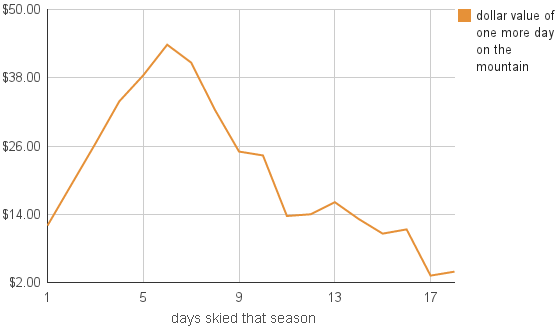
Trends
It’s been awhile since we correlated the number of days a skier spends on the mountain to his/her renewal rate the next winter. Today, we decided to jump back into that data. Every day a passholder skis makes them more and more likely to renew, but what’s the dollar value of each one of those days? Here’s what we found.
The Goods
To find our answer we used the same data set as the first round. This time, however, we also found the average adult season pass prices for all of those mountains and did some math.
Let’s say we have a group of 100 skiers. After 5 days of skiing, there’s about a 44% chance they’ll renew. If passes cost $1,000 and 44 of them renew, that’s $44,000 of revenue or $440/skier. If all 100 ski one more day, the likelihood of them renewing is about 50%, 50 of them renew, which nets $50,000 in revenue or $500/skier. So the value of a skier with 5 days under their belt skiing one more day is about $60. Here’s how it looks with the average season pass price from these resorts applied:

As expected, the steepest part of the graph from our original analysis correlates to the highest value. Before 3 days and over 8-9 you’ll see a lower value to each additional day skied, but the sweet spot – somewhere around 4-7 days – is where every additional day a passholder spends on the mountain pays off significantly in terms of renewal rates and future pass revenues.
What This Means
The big question this answers, especially when you run it for your resort’s skiers, is that you can begin to see the value of a season passholder not just buying their pass, but using it as well. It’s not just about making the sale, future revenues are increased simply by the pass being used.
With a dollar figure on different stages of use, you can begin to evaluate the trade-offs between what might lure them back for another day or two of skiing and the value you get from those extra days on the mountain.